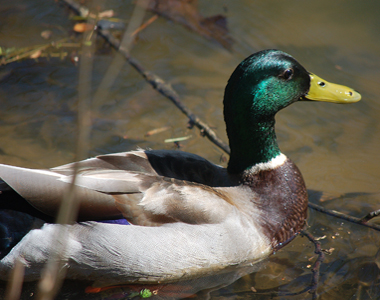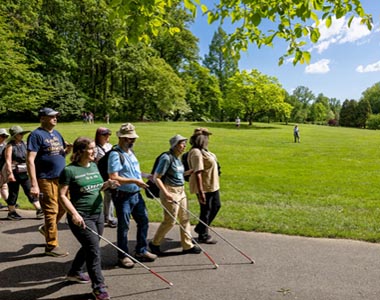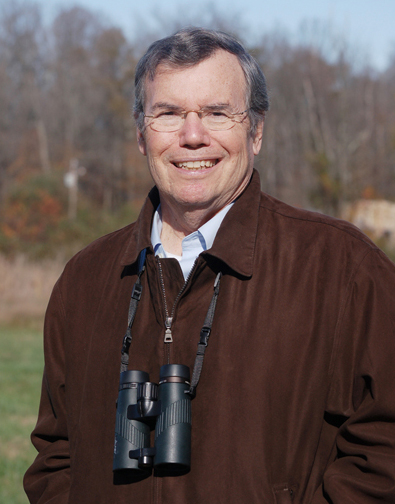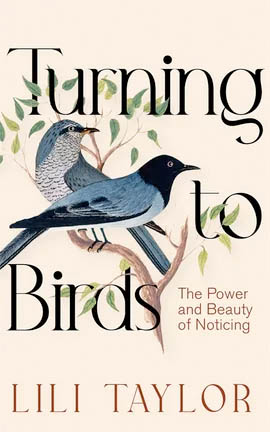| |  As spring warbler migration ends, we slide into summer – sometimes to the shore and beach, or perhaps a vacation in wooded, cooler climes. Or, we explore and slow bird in the backyard or local spots the kids may like. As spring warbler migration ends, we slide into summer – sometimes to the shore and beach, or perhaps a vacation in wooded, cooler climes. Or, we explore and slow bird in the backyard or local spots the kids may like.
A local duck pond, lake, or stream can be a good place to introduce kids up close to the world of birds. But Ross Feldner, RCC’s bird booster who has yet to meet a winged friend he doesn’t like, opens our May issue of Bird Watch and Wonder with “No Crackers for the Quackers.” It’s a gentle lesson for the kids, and for us, why it is not a good idea, no matter how much fun, to toss bread to ducks, geese, and other birds.
 The quack of a duck may be the first bird we ever heard and remembered as youngsters, but birdwatching as a national pastime, as its name implies, has been geared toward seeing birds (with the best binoculars or scope you can possibly afford). But our ears (assisted by various apps) can easily find all the birds around us. That’s why we welcome and feature the first nationwide “blind bird-a-thon” where over 200 participants could identify a cedar waxwing without even a glimpse of its mask, crazy little crest, tawny and burnished gold body, or the yellow tip of its tail. The quack of a duck may be the first bird we ever heard and remembered as youngsters, but birdwatching as a national pastime, as its name implies, has been geared toward seeing birds (with the best binoculars or scope you can possibly afford). But our ears (assisted by various apps) can easily find all the birds around us. That’s why we welcome and feature the first nationwide “blind bird-a-thon” where over 200 participants could identify a cedar waxwing without even a glimpse of its mask, crazy little crest, tawny and burnished gold body, or the yellow tip of its tail.
This new sport we might call “birdlistening” holds hope and promise for all those birds who are discriminated against simply because they are “plain” or “dull” or “nondescript.” Take the little-noticed song bird of the arid Southwest, the Gray Vireo. Silas Fischer of the University of Toledo reports it gets only one-third the attention, mention, and research of more colorful birds. In his column “For the Birds," lifelong birder Chris Bosak admits with a touch of guilt that only recently has he noticed the Warbling Vireo on his walks. Why had he paid no attention to this marvelous, loquacious bird? You guessed it. Because the Warbling Vireo is “fairly nondescript” and hangs out in the middle or upper branches among the leaves. Underappreciated dull birds are also the theme of this year’s 2025 National Black Birder’s Week (May 25-31) where sparrows, dismissively called LBBs (little brown birds), will get full attention and appreciation at the nation’s premier Black birding event which you can find in our “Events” section. Lovers of literature and of bird sounds will also be glad to discover in our “Bird Lore” section that the mockingbird, master of imitation and bird sounds, has managed for the fourth straight year to survive efforts to take away its title as the state bird of Florida. Lawmakers there continue to look for ways to do in the skilled black and white singer for more colorful and tourist producing birds like the pink flamingo. The early and lifelong love of birds, whether dull or dazzling, ultimately leads us to understand and appreciate their important role in ecological systems. Birdwatchers and birdlisteners alike will be equally glad to learn that through the careful observation of birds, with eye and ear, woodpeckers – whom we often hear rather than see—are proving to be a growing and important check on the notorious emerald ash borer which has destroyed huge swaths of ash forest across the United States (40 million ash trees in Michigan alone). So check out, then, the most spectacular of our woodpeckers in “10 Fun Facts About Pileated Woodpeckers” in “Bird Findings” The Pileated Woodpecker is described as a “gateway bird” for kids (or novices) that is unmistakable both for it crow-like size and big red crest, but also for its call – loud, escalating shrieks that bring to mind a maniacal laugh that can be heard across the woods. However you encounter birds this summer, whether by eye or ear, at home, or off in some heavenly getaway, be sure to read or listen to award-winning actor Lili Taylor’s Turning to Birds: The Power and Beauty of Noticing. You will find there why, after all, we care so much about the birds. Taylor brilliantly recounts her intimate encounters with birds which, perhaps like yours, have captured her heart and her imagination. | | | | | |  Bob Musil is the President & CEO of the Rachel Carson Council and author of Rachel Carson and Her Sisters: Extraordinary Women Who Have Shaped America’s Environment (Rutgers, 2016) and Washington in Spring: A Nature Journal for a Changing Capital (Bartleby, 2016). He is also the editor of the forthcoming annotated edition from Rutgers University Press of Rachel Carson’s Under the Sea-Wind with his Introduction, updated marine science, and historic and contemporary illustrations and photographs. Bob Musil is the President & CEO of the Rachel Carson Council and author of Rachel Carson and Her Sisters: Extraordinary Women Who Have Shaped America’s Environment (Rutgers, 2016) and Washington in Spring: A Nature Journal for a Changing Capital (Bartleby, 2016). He is also the editor of the forthcoming annotated edition from Rutgers University Press of Rachel Carson’s Under the Sea-Wind with his Introduction, updated marine science, and historic and contemporary illustrations and photographs. | | | | | | Don’t Give Crackers to Quackers Some people have the mistaken idea that birds like bread when in fact it’s bad for them. You will often see people throwing bread out for ducks and geese. While they may think this is helping them, what they don’t realize is… Bread is really, really bad for birds. Basically, bread robs birds of the opportunity to take in the true nourishment their bodies require to survive. Bread offers wild birds absolutely ZERO nutrition. ZERO. But, how could it possibly harm them, if it has zero effect? Simply, bread fills up a small stomach in a hurry. | | | | | | | | A Song and a Chirp: How Blind Birders Tell a Robin From a Wren First nationwide “blind birder bird-a-thon” draws more than 200 participants with goal of introducing people to the hobby. Maitreya Shah heard the bird’s distinctive chirp in a nearby tree at a botanical garden in the Maryland suburbs. But he’s blind and couldn’t see it. With his arm stretched upward, he held his iPhone up to try to capture the sound as an app identified the bird. “It’s a cedar waxwing,” the 27-year-old told his fellow blind birders as they walked on a paved path surrounded by grass and flowers at Brookside Gardens in Wheaton, Maryland. | | | | | | | | New Tool Lets Birds Help Track - and Save - Wild Bees An estimated 3,600 species of wild bees serve as pollinators in the U.S., playing a crucial role for the nation’s agriculture. But those bee populations appear to be in decline, and with scant data on wild bees, conservation efforts have proven difficult. A new publicly available tool, developed by the Cornell Lab of Ornithology and the Cornell Atkinson Center for Sustainability, can track and estimate the diversity of wild bees using one of Cornell’s greatest areas of expertise: birds. | | | | | | | | How to Make a Safe, Successful Home for our Feathered Friends For many species of birds, there is a shortage of great places to nest. There may be birds that would love to call your habitat home, but they have a specific nesting requirement which needs to be met. Birdhouses can be placed in backyards, schoolyards, parks, orchards, farms, pastures, cemeteries, woodlots, deserts, cities…you name it. Support more nesting birds, and give a bird a home. Use these resources to become the ultimate nest box landlord. | | | | | | | | ‘At Work With’ an Air Traffic Controller — For Birds — at the Portland Airport When you think of airports, you probably picture security lines, baggage claims, and maybe air traffic control towers. But if you squint out your window seat, just past the runways at Portland International Airport, you might spot a team keeping watch over an entirely different kind of traffic — the feathered kind. | | | | | | | | Weakened Migratory Bird Treaty Act Is a Major Setback for Wildlife Conservation On April 11, a legal opinion issued by the Department of the Interior concluded that the Migratory Bird Treaty Act (MBTA) does not apply to the incidental, yet predictable and preventable killing of migratory birds. Under the new opinion, energy and utility companies will no longer be held liable for bird mortalities from industry hazards such as open oil waste pits, tall communication towers, and powerlines. Hence, they no longer have any incentive to try to protect birds at their facilities. | | | | | | | | The Verona Library Put Stickers on its Towering Windows. It’s For the Birds At peak migration season, bird advocates recently completed one of many efforts to stop birds from colliding into windows. On Friday, the Verona Public Library near Madison debuted floor-to-ceiling translucent dot stickers on its 35-foot tall glass windows. The treatment comes after volunteer citizen scientists with Southern Wisconsin Bird Alliance, formerly known as Madison Audubon, documented 88 bird deaths while periodically surveying the windows since 2021. | | | | | | | | 10 Fun Facts About the Pileated Woodpecker The Pileated Woodpecker is a fabulous gateway species into birding—especially for young kids. Large and easy to observe without binoculars, the Pileated is native to Canada, the Pacific Northwest, and the eastern half of the United States. The impressive bird is best known for its distinctive and prominent red crest, which contrasts sharply with its white-and-black face striping, black body, and black wings with white patches. Glimpsing one of these birds in the wild will leave anyone in awe, but here are some fun facts that will make you further appreciate this charismatic species. | | | | | | | | New Analysis Reveals That ‘Beautiful’ Birds Are Studied Much More Than ‘Drab’ Species A study reviewing 50 years of scientific literature shows that familiar, visually appealing avians are the subject of three times more research than their plainer cousins. Silas Fischer, a PhD candidate at the University of Toledo, has been studying Gray Vireos since they were an undergraduate. Gray Vireos, songbirds of the arid woodlands of the Southwest, are very, well, gray, often described in field guides with phrases like “one of North America’s most nondescript birds.” | | | | | | | | What’s the Best Book or Field Guide For Bird Identification? A good field guide is one of the most important tools to help identify birds. Traditionally, field guides took the form of books, often quite big books, that for field use could be heavy or vulnerable to wetting on rainy days. Nowadays there are also some great smartphone apps as well, making bird ID fit into the palm of your hand. Many people rely on both books and apps to identify birds; below are some of our favorite guides for North America. | | | | | | | | For the Birds: Discovering Something New is a Treat It’s funny how you can still discover new things after so many years. I’m sure that applies to most hobbies, but it certainly applies to birdwatching. I have only recently “discovered” the warbling vireo. The small, loquacious bird, of course, has been around for far longer than I have been birdwatching, but I am only recently taking notice of it. Part of the reason I may not have paid it much mind previously is that it is a small, fairly nondescript bird that typically hangs out in the middle to upper branches among the leaves. | | | | | | | | The Ballad of U10: How One Mischievous Bird Taught Me to Love Gulls Even More After a chance beach encounter with a banded Herring Gull, cartoonist Rosemary Mosco dug deep into the surprisingly popular bird's life and adventures. One mid-September afternoon on a beach in northern Massachusetts, I witnessed a crime. I was tempted to dip my toes in the still-warm sea, but I’m a birder, so I got distracted taking photos of gulls. One individual caught my eye: It had a metal band around one ankle and a plastic band around the other, put there by researchers to help study the species. Finding a banded bird is a lucky break. | | | | | | | | | | Mockingbird Keeps Perch as State Bird as Bills Flop Favoring Others in Capitol The gray and white bird held off challenges for a fourth consecutive year in the Capitol to unseat it from its perch as Florida's state bird. The northern mockingbird has done it again. Known for its ability to vocally mimic at least a dozen other species, the gray and white bird held off challenges for a fourth consecutive year in the Capitol to unseat it from its perch as Florida's state bird. Lawmakers this year even tried some new strategies. | | | | | | | | The Curious Case of the Pygmy Nuthatch There is nothing quite like becoming birdpilled. I am not a halfway kind of person: When I got into movies, I turned thinking about movies into my job. When I got into running, it wasn’t long until I was running a half-marathon every weekend. So I know what it’s like to become obsessed—and to start seeing your new obsession everywhere. But during lockdown, I, like a lot of people, gradually became obsessed with birds—and it turns out that, with birds, they really are everywhere. | | | | | | | | Senate Introduction of Fix Our Forests Act Offers Path to Address Wildfire Risks to Forests, Communities Today, a bipartisan group of senators introduced the Fix Our Forests Act, which provides direction for improving management of our forestlands to reduce wildfire risk, which in turn supports vital habitat for birds and local communities. Introduced by Sens. John Hickenlooper (D-CO), John Curtis (R-UT), Alex Padilla (D-CA), and Tim Sheehy (R-MT), the legislation is based on the Fix Our Forests Act (H.R. 471), spearheaded by Reps. Bruce Westerman (R-AR) and Scott Peters (D-CA). | | | | | | | | North American Bird Populations Suffering Severe Decline North American bird populations are declining most severely in areas where they should be thriving, according to a groundbreaking study published May 1 in Science. Researchers from the Cornell Lab of Ornithology set out to develop reliable information about where birds are increasing or decreasing across North America, but the patterns they uncovered were startling. Birds are declining most severely where they are most abundant – the very places where they should be thriving. | | | | | | | | Helping Birds and Floating Solar Energy Coexist From a small California winery to a large-scale energy project in China, floating photovoltaics—or "floatovoltaics"—are gaining in popularity. Commonly installed over artificial water bodies, from irrigation ponds and reservoirs to wastewater treatment plants, floating solar projects can maximize space for producing clean energy while sparing natural lands. But where there is water, there are waterbirds. Little is known about the impacts—positive or negative—floating solar projects may have on birds and other wildlife. | | | | | | | | Birds Have a Role to Play in Confronting a Notorious Tree-Killing Beetle Sometime in the early 1990s, the generally accepted origin story goes, a bargeload of freight from Asia arrived in metro Detroit. Onboard were stowaways that would dramatically transform North American forests: insect larvae pupating in packing crates made of Eurasian ash. Having fattened on inner bark while the trees still stood, the larvae survived both the sawmill and an overseas voyage to emerge in southeast Michigan as iridescent green beetles called emerald ash borers. They flew off with one purpose—to find more ash trees. They did. | | | | | | | | Poems About Birds Poems about birds have long captivated the imagination, serving as symbols of freedom, transcendence, and beauty. They represent both the earthly and the ethereal. Their variety, too, means that hundreds of different poems about every possible bird is out there. I wish I could include them all here. Poems about birds evoke a sense of wonder and mystery. Whether serving as messengers of love, omens of fate, or simply as embodiments of grace and elegance, poems about birds constantly amaze. | | | | | | | | Grand Rapids, Michigan Students Dominate Kirtland's Warbler 2025 Young Artists Contest Winners' Circle Almost 1,000 contest entries for the annual Kirtland’s Warbler 15-month calendar received from Michigan, Canada, and the Bahamas The Huron-Manistee National Forests (HMNFs) received 970 entries for the 2025 Kirtland's Warbler Young Artists' Contest from kindergarteners through eighth graders. Three Grand Rapids, Michigan students swept the 2025 contest with their entries. | | | | | | | | 7 of the Best Songs About Birds Often symbolizing new beginnings, hope, and freedom, birds are also a symbol of peace and prosperity, and joy as well as grace, strength, and courage. Eagles, doves, and all sorts of aves have been admired in song with artists connecting to the gracefulness and assorted symbolism linked to these creatures—from Bobby Day’s 1958 doo-wop hit “Rockin’ Robin,” and Bob Marley & The Wailers’ “Three Little Birds,” to The Police’s “Canary in a Coalmine,” and the Electric Light Orchestra, and Linda Ronstadt’s “Skylark,” among many others. | | | | | | | | Black Birders Week This year #BlackBirdersWeek is from Sunday, May 25 to Saturday, May 31, organized by The Black AF In STEM Collective – a collective that “seeks to support, uplift, and amplify Black Science, Technology, Engineering, and Mathematics professionals in natural resources and the environment through professional development, career connection, and community engagement.” This year’s theme is Grounded in Community. "This is a space where Black birders, scientists, and nature enthusiasts are not just participants but visionary leaders and changemakers, reshaping narratives and demanding equity in every arena." | | | | | | | | | | Red Crossbill The Red Crossbill, also known as the Common crossbill, is a small bird in the finch family. Its name comes from distinctive mandibles, crossed at the tips, which enable them it to extract seeds from conifer cones and other fruits. With the right habitat, Red Crossbills have a wide range across parts of North America, inhabiting southern taiga forests from Alaska to Newfoundland, and montane coniferous forests south to Georgia in the high Appalachians, Arizona, New Mexico, and the Sierra Nevada of California. | | | | | | | | Momentary Meditations are published every Monday to awaken what Rachel Carson called “the sense of wonder” and what Albert Schweitzer called “a reverence for life.” Looking deeply into our interdependence with all life on earth helps us know what we must do. In our harried world, these meditations are meant to serve as a renewable resource for compassion and love. Diverse Families Gather Together One delight followed another – mallards, wood ducks, Canada geese gathering, all seeming to say one thing, “It’s good to be alive together this day.” | | | | | | | | | | Turning to Birds The Power and Beauty of Noticing By Lili Taylor  Discover an eye-opening world of meaning in small moments with this search for peace in a cacophony of birds – from award winning Actor Lili Taylor. Discover an eye-opening world of meaning in small moments with this search for peace in a cacophony of birds – from award winning Actor Lili Taylor.
During a much-needed break from her work as an actor, Lili Taylor sought silence and instead found the bustling, symphonic world of birds that had always existed around her. Since then, she has entered the world of birdwatching and kept a keen eye pressed to her binoculars in search of vivid stories that elevate the everyday, if you only look.
Through a series of beautifully crafted essays, Taylor shares her intimate encounters with the birds that have captured her heart and imagination – from learning the virtue of patience from the Gambel’s quail in New Mexico to experiencing a moment of connection with the wonderfully strange woodcock in Ohio; from the exhilaration of witnessing a migratory flock from the top of the Empire State Building to the quiet joy of observing a nest of hatchlings in her own backyard. Through simply paying attention to birds, Lili has seen a parallel world that is wider and deeper, one of constant change and movement, full of life and the will to survive.
In Turning to Birds, Taylor encourages mindfulness, inviting you to be present and fully engaged with the world around you. Her beautiful prose and thoughtful meditations on both the art we make and the art we discover around us create a sense of intimacy and wonder, inviting you to see the world through new eyes and to find joy in the most unexpected places. Purchase here | | | | | | | | The M 2025 issue of Bird Watch and Wonder was produced by Ross Feldner | | | |  The Rachel Carson Council Depends on Tax-deductible Gifts From Concerned Individuals Like You. Please Help If You can. The Rachel Carson Council Depends on Tax-deductible Gifts From Concerned Individuals Like You. Please Help If You can. | | | |  Sign Up Here to Receive the RCC E-News and Other RCC Newsletters, Information and Alerts. Sign Up Here to Receive the RCC E-News and Other RCC Newsletters, Information and Alerts. | | | | | | | | | | | |